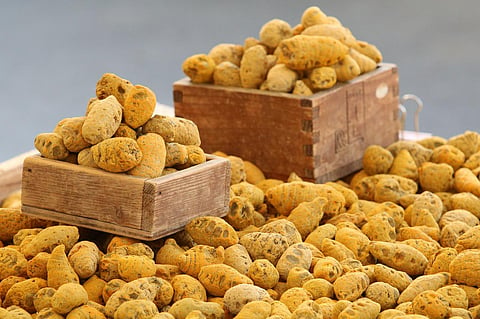Wonder Spice Turmeric Set To Change The Fortunes Of Kushinagar
Lucknow/Kushinagar, June 11 (TNA) Turmeric has a long history of it's use in Asian, African and Caribbean cuisines and soon this Indian spice will be declared as One District One Product (ODOP) of Kushinagar and popularised among farmers.
With Turmeric becoming the ODOP of Kushinagar, the Buddhist pilgrimage site has the potential to become like the Erode, Sangli and Nizamabad districts of South India, known for it's high volume cultivation. The traditional way of cultivation of turmeric in Kushinagar has a long history. It is mainly cultivated in Dudahi, Ramkola, Bishunpura, Khadda, Severhi, Kaptanganj, Kathkuiyan, and Fazilnagar.
Working towards the interest of farmers is the foremost priority of the Yogi Adityanath government. In this regard, the government will explore the possibilities of cultivation of turmeric in Kushinagar at its level. In 2014, the Sustainable Human Development Association (SHDA), an organisation working among farmers in collaboration with Tata Trusts, started a planned effort to cultivate it.
According to the data received from the concerned departments, turmeric is cultivated on about 800 hectares in the entire district. The yield per hectare is about 36.77 quintals. As per ground reports, the data collected by the organisation, turmeric is cultivated on more than 200 hectares in Ramkola block alone. Accordingly, the area under cultivation of turmeric will be about three times.
The yield of local and developed species in the trial ranges from 150 to 400 quintals, respectively. At present, about 10,000 farmers of the district are associated with the cultivation of turmeric. According to Agricultural officer BM Tripathi, in the Agro climate zone of Kushinagar, Rajendra Sonia, Rajendra Sonali, Narendra Haldi-1 are the highest yielding species if the farmers are trained on a large scale about the improved methods of farming.
If quality seeds of better species are provided and cooperation in processing, packing and marketing of the produce is given, then turmeric can change the fortunes of the farmers of Kushinagar, once infamous for poverty, hunger and malnutrition.
Efforts have also been started in this regard by Tata Trusts at a limited level. For example, a company was formed by joining 1,150 farmers. All farmers are stakeholders in this project.
A processing unit of limited capacity has also been set up, but the government will have to come forward to make Turmeric a brand like Kala Namak Rice of Siddharthnagar.
Kushinagar is a district of Purvanchal adjoining Bihar. It has better connectivity from Bihar to Bengal and northeastern states by a four-lane road. Once the international airport is built, it will be accessible to must countries too.

